TUCK, RR Stanford (#9)
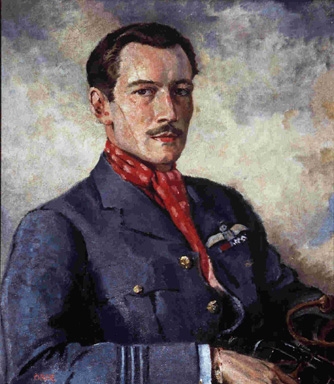
#9
Wing Commander Robert Roland 'Bob' Stanford TUCK DSO DFC** AFC (27+e/a)
Royal Air Force
1 July 1916 – 5 May 1987
‘a courageous officer who defended this nation in the skies
above Kent during the Battle of Britain in 1940’
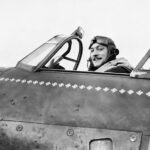
Official photograph (CH 1680) Squadron Leader Robert Stanford Tuck, commanding No. 257 Squadron, in the cockpit of his Hawker Hurricane at Martelsham Heath, November 1940. Copyright: © IWM. Original Source: http://www.iwm.org.uk/collections/item/object/205212597
“Robert Tuck was born in 1916 in Catford, and attended a local school, which he left with minimal qualification,s to join the merchant navy as a cadet when he was 16. He then dropped out to join the RAF whilst on leave at the age of 19. There he was initially described as a ‘slow learner’ and was almost sent home, but he persevered and soon took to flying better than anything else he’d tried – by the end of his training his rating had been raised to ‘born pilot’.
He was involved in a midair collision in 1938 which taught him the value of calm and a cool head, and that lesson helped him to be selected as one of the first batch of pilots to be trained in flying a new fighter – the Spitfire – later that year. By the time war broke out Bob was a flying officer involved in test flying until in May 1940 he was posted to 92 Squadron at Biggin Hill.
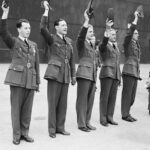
ROYAL AIR FORCE FIGHTER COMMAND, 1939-1945. (CH 432) After an awards ceremony at Hornchurch, Essex, decorated RAF pilots cheer King George VI. They are, (left to right): Flying Officer J L Allen, Flight-Lieutenant R R Stanford Tuck, Flight-Lieutenant A C Deere, Flight-Lieutenant A G Malan, Squadron-Leader J A Leathart and an airman bugler. Allen, Deere, and Leathart, all serving with No. 54 Squadron RAF, had, between them, shot down 25 enemy aircraft. © IWM. Original Source: http://www.iwm.org.uk/collections/item/object/205126762
Bob’s first combat patrol as flight commander was a trial by fire; flying defence over Dunkirk on the 23rd of May 1940. He downed one Me109 and two ME110s on that first day, but his squadron lost five pilots including their squadron commander and flight commander. Tuck took command and led the squadron back on the 24th where he shot down a further two Dornier bombers, claiming his Ace on his second day of combat. By the time the Dunkirk evacuations were over, Tuck had six kills and was awarded the Distinguished Flying Cross (DFC) on the 11th of June.
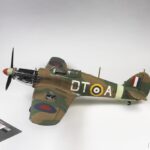
Aircraft Scale Model, Hawker Hurricane I: British (MOD 597) model (1950, wood and plastic, maker Cyril McCann) © IWM. Original Source: http://www.iwm.org.uk/collections/item/object/30018327
As the German offensive pushed forward and became the Battle of Britain, 92 Squadron was reassigned to South Wales leaving Tuck itching for combat duty and involved only in seeing off the occasional probing raid over Bristol. However, as RAF losses rose 92 were diverted to combat increasingly often. On the 18th of August Bob was shot down for the first time, baling out over Kent. A week later his Spitfire was seriously damaged in combat against a Do17 over the English Channel and lost its engine, but he treated the plane as a glider and coaxed it 15 miles back to land before putting down in a field.

Between June and the end of September 1940 Tuck scored at least an additional six kills, with as many as six more considered likely including the German Ace Hans-Joachim Marseille on the 23rd of September, and he was awarded his second DFC in October.

Runway Perspective by Eric Ravilious © IWM. Original Source: http://www.iwm.org.uk/collections/item/object/22477
On the 11rd of September he took command of 257 Squadron flying Hurricanes. It was an inauspicious start, as Tuck disliked his new plane and squadron morale was poor. However, he quickly changed his mind as the Hurricane proved to be a sturdy gun platform, and morale improved after a succession of victories.
In January Bob was awarded the Distinguished Service Order (DSO) and in April the DFC for the third time. By this time he was such a regular visitor to Buckingham Palace to receive medals that the King joked his daughters had been asking when he would come and visit again.

Fighter Affiliation : Halifax and Hurricane aircraft co-operating in action (Art.IWM ART LD 3769) © IWM. Original Source: http://www.iwm.org.uk/collections/item/object/19400
On June 21st 1941 Tuck downed two further Me109s over Kent before being shot down again, baling out over the channel to be rescued a few hours later. By July he was promoted again to Wing Commander and posted to RAF Duxford before returning to Biggin Hill and back to flying Spitfires.
However his luck had to run out sooner or later, and on January 28th 1942 he was brought down by flak over France. His German captors were so delighted by the display of skill that Bob had shown in trying to avoid damage that the Luftwaffe threw a party for him before he was sent to Stalag Luft III to sit out the rest of the war…or so his captors presumably thought.

ALLIED PRISONERS OF WAR IN GERMANY, 1939-1945 (HU 1605) Squadron Leaders Robert Stanford Tuck and Roger Bushell (Big X) in Stalag Luft III, Sagan. Copyright: © IWM. Original Source: http://www.iwm.org.uk/collections/item/object/205234086
Instead, Tuck made several escape attempts before finally succeeding in February 1945. He made his way to the Russian lines and joined the Red Army advance as an infantry officer for a month before travelling to the British Embassy in Moscow and being sent home in April.
Tuck’s wartime air combat tally is officially recorded as thirty kills, seven probable and seven damaged, making him the UK’s second deadliest pilot in less than two years of service. After the war he was awarded the DFC again, this time by the United States, and worked as a test pilot for the RAF for several years before leaving and starting a mushroom farm in Kent.
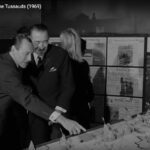
Wing Commander Tuck talking to his lifelong friend, German Ace Adolf Galland at an event in Madame Tussaud’s marking the release of the 1969 film “The Battle of Britain”.
Battle of Britain at Madame Tussaud’s (1969) by British Pathe
CU Wax work of Adolf Hitler at Madame Tussauds. CU Hand holding cigar. Pan up to wax work of Sir Winston Churchill. CU Churchill’s head. AS Spitfire hanging from ceiling. SV Pilot in cockpit. Pan to show the guns. GV Reception at Mme. Tussauds. SV Zoom in to Henry Hall talking to people. CU Wing Commander Stanford Tuck. SV Zoom in to CU, Squadron Leader James Lacey. SV Squadron Leader Boleslaw Drobinski, talking to people. CU Squadron Leader Drobinski. SV Wing Commander Clare Legge, woman controller at time Battle of Britain, talking to Group Captain Tom Glebe.
CU German General Adolph Galland talking to Wing Commander Stanford Tuck. SV pan to map of battle area. Pan back to Wing Commander Tuck talking to Adolf Galland. SV Pan old papers that were printed at time of the Battle of Britain. CU Sign stuck onto broken window, ‘Business as Usual’. SV Looking through the window of models. CU Model of lady’s head with hat on. SV Elsie and Doris Waters looking in the window. SV War time radio. Pan to Alvar Lidell. SV Vera Lynn with family listening to radio. SV Interior bomber.
He became lifelong friends with German fighter ace Adolf Gallard, who had thrown the party for him after his capture in 1942, and became godfather to Gallard’s son. He died in 1987.” (David Wade)

Plaque in St Clements Church Sandwich, Kent, commemorating Wing Commander Robert Stanford Tuck.
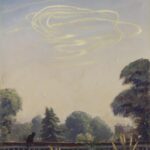
An Aerial Battle by Francis Dodd,6 September, 1940. (Copyright IWM)
High Flight
by John Gillespie Magee Jr. (9 June 1922 – 11 December 1941)
Oh! I have slipped the surly bonds of Earth
And danced the skies on laughter-silvered wings;
Sunward I’ve climbed, and joined the tumbling mirth
Of sun-split clouds, – and done a hundred things
You have not dreamed of – wheeled and soared and swung
High in the sunlit silence. Hov’ring there,
I’ve chased the shouting wind along, and flung
My eager craft through footless halls of air…
Up, up the long, delirious burning blue
I’ve topped the wind-swept heights with easy grace
Where never lark, or ever eagle flew –
And, while with silent, lifting mind I’ve trod
The high untrespassed sanctity of space,
Put out my hand, and touched the face of God.

John MaGee, the Canadian fighter pilot who died aged 19, author of “The Pilots’ Poem”, ‘High Flight’


